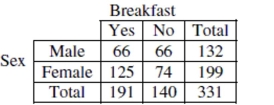A survey of an introductory statistics class in Autumn 2003 asked students whether or not
they ate breakfast the morning of the survey. Results are as follows: 
a. What is the probability that a randomly selected student is female?
b. What is the probability that a randomly selected student ate breakfast?
c. What is the probability that a randomly selected student is a female who ate breakfast?
d. What is the probability that a randomly selected student is female, given that the student
ate breakfast?
e. What is the probability that a randomly selected student ate breakfast, given that the
student is female?
f. Does it appear that whether or not a student ate breakfast is independent of the student's
sex? Explain.
Definitions:
AFL-CIO
The American Federation of Labor and Congress of Industrial Organizations, a national trade union center in the United States.
California Labor Relations Act
Legislation aimed at regulating the relationship between workers and employers in California, often focusing on collective bargaining rights.
Boycott
A collective and intentional act of abstaining from using, buying, or dealing with an organization as an expression of protest.
Confounding Variable
A variable that influences both the dependent and independent variables, causing a spurious association.
Q3: In the study "The Role of
Q12: If you think that the temperature might
Q16: We have calculated a confidence interval
Q17: The following is a scatterplot of
Q31: Flight costs Every year Educational Services
Q37: The two samples whose statistics are
Q40: Last year, the average math SAT score
Q84: Test an appropriate hypothesis and state your
Q91: A regression model examining the amount
Q122: What is the probability that exactly 2